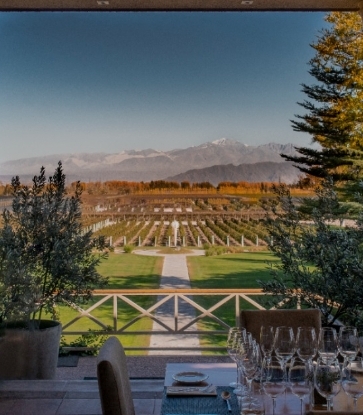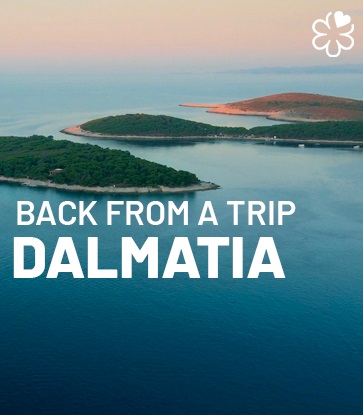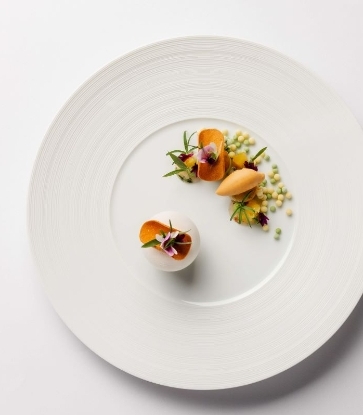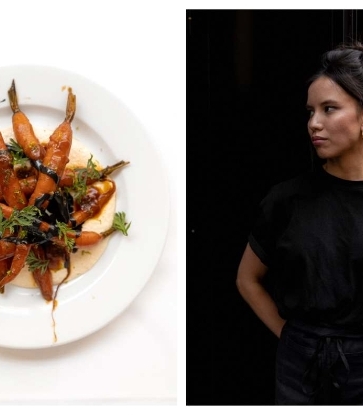As varied as it is abundant, the region's natural and agricultural resources have nurtured a rich gastronomic tradition, a dazzling reflection of the French art of living. Home to François Rabelais - and his insatiable Gargantua character - the region is also the one that succeeded in having the "Gastronomic Meal of the French" inscribed on UNESCO's list of Intangible World Heritage Sites ! The countless local products that invade the region's lively markets every day are naturally showcased by local chefs and restaurateurs ; ambassadors of the Loire region's flavours, distinguished each year in the MICHELIN Guide selection. Whether at the helm of a Michelin-starred restaurant or a bistro, they all invite their guests to discover the Centre-Val-de-Loire through its cuisine and gustatory wonders, such as the five goat cheeses protected by PDO (Valençay, Sainte-Maure-de-Touraine, Pouligny-Saint-Pierre, Selles-sur-Cher, Crottin-de-Chavignol) or the many wines classified as AOC or IGP.

Nature and culture, an exceptional encounter
A visit to the Centre-Val de Loire region is an opportunity to discover a vast territory where nature and culture come together in harmony. With its many tributaries such as the Cher, Indre, Loir, Creuse and Vienne, the Loire is both the backbone of the region and its cultural heart. Shaped by man for two millennia, its exceptional landscapes are the result of constant interaction between the river, the people who live along its banks and their environment. A major route for the spread of the Italian Renaissance in France, the Loire Valley and its castles - between Sully and Chalonnes - have been on UNESCO's World Heritage list since 2000. In addition to the Loire Valley, two other sites in the region have also been classified as UNESCO World Heritage Sites : Chartres Cathedral and Bourges Cathedral, which has just been designated European Capital of Culture for 2028..
With 5,000 km of cycle paths, the Centre-Val de Loire region is also France's No. 1 destination for bicycle travel. The region invites you to practice virtuous slow tourism, irrigated by an infinite number of greenways and cycle routes. The most famous of these is La Loire à Vélo (EuroVelo 6), which crosses the region superbly from one end to the other (over 900 km in all). But there are many others, such as the Scandibérique, Indre à Vélo, Cœur de France à Vélo (along the Cher and Berry canals), Vallée du Loir and Véloscénie, which criss-crosses a large part of the Eure-et-Loir region. It's also an opportunity to discover the region's exceptional biodiversity, particularly in its 3 regional nature parks (Loire-Anjou-Touraine, Brenne and Perche).
.

Itineraries in the Loire Valley
In Indre-et-Loire, the river offers a royal road to discovery. In this département, which is often associated with the Touraine region, you'll find a thousand gourmet delights : rillons or rillettes from Tours, cheeses from Sainte-Maure-de-Touraine, black truffles, poires tapées, nougat from Tours... And to accompany the delights, the delicate wines of Chinon, Bourgueil, Vouvray or Montlouis. Along the Eurovélo 6, you'll also discover a rich heritage: the département boasts over 150 castles ! Each with its own special character. There's the Château de Chinon (where Charles VII met Joan of Arc), Villandry (famous for its medieval gardens), the Château de Langeais (a fortress frequented by Louis XI), the Château du Rivau (and its thousands of roses), the mighty fortress of Loches... Among the most famous are Chenonceau, which straddles the Cher, and Azay-le-Rideau, surrounded by water. And let's not forget Amboise, where Leonardo da Vinci is buried. Then there's the Plus Beaux Villages de France of Candes-Saint-Martin, Crissay-sur-Manse and Montrésor. Nature lovers will not be outdone : in addition to the pleasant banks of the Loire and Cher rivers, they can stroll through the forests of Loches and Chinon, or enjoy the ponds of Le Louroux.Further east, the Loir-et-Cher has nothing to envy its neighbor. At the table, you'll enjoy Sologne caviar, asparagus, Selles-sur-Cher PDO goat's cheese and Perche clover. AOC Cheverny and Touraine wines are increasingly popular. Here too, visitors can enjoy an exceptional heritage : Blois and its château (where the Duke of Guise was assassinated), Chambord (designed by Leonardo da Vinci), Chaumont-sur-Loire (home to the famous International Garden Festival), the château de Cheverny (whose silhouette inspired Hergé's Moulinsart) and the little-known château de Talcy. There are many charming villages to explore, including Saint-Dyé-sur-Loire and Lavardin (classified as France's Most Beautiful Villages). When it comes to nature, you'll be spoilt for choice: the wild banks of the Loire and Cher rivers, the moors and forests of Sologne, the meadows of the Perche vendômois. A complete green program.

In the Loiret region, sometimes referred to by its former name of Orléanais, you can enjoy fresh vegetables (such as Sologne asparagus), pithiviers (sweet or savory puff pastry) or andouilles de Jargeau. Vinegar and Orléans mustard are used for seasoning. And saffron, grown in the region since the Middle Ages. The cheeses are also remarkable, like the olivet cendré. For dessert, try Orléans fruit macaroons or Montargis pralines. For refreshment, try the fine wines of Coteaux du Giennois or AOC Orléans-Cléry, a vineyard in full renaissance. History buffs won't want to miss a visit to Orléans, forever linked to Joan of Arc. Montargis, nicknamed the "Venice of the Gâtinais", is also well worth a visit, as is the Château de Sully-sur-Loire. The charming villages of Meung-sur-Loire and Yèvre-le-Châtel (listed as the most beautiful village in France) also offer pleasant walks. Romantics can follow the Route de la Rose, while aesthetes can discover Gien and its Musée de la Faïencerie. In addition to the wild banks of the Loire, nature lovers can explore the Orléans forest (the largest in mainland France) and the moors of the Loiret Solognot region.

Itineraries in Berry
In the Cher region, which is part of Berry, you'll be delighted by green lentil soup, potée berrichonne or the famous Crottin-de-Chavignol (AOP), a goat's cheese produced in the Sancerrois area. All to be accompanied by wines from Sancerre, Menetou-Salon, Reuilly or Quincy (the oldest AOC in the Loire Valley). In terms of heritage, take time to discover the charming city of Bourges and its Unesco-listed cathedral, before setting off on the Route Jacques Cœur, an itinerary that brings together 18 major monuments in the Cher region. A stop at Noirlac Abbey is highly recommended. Another not-to-be-missed stop is the Domaine de George Sand in Nohant, which offers a glimpse of the famous author's private life. Then there's Valençay castle, the village of Apremont-sur-Allier and, of course, Sancerre. For nature breaks, head for the vine-clad hillsides of the Sancerre region, the verdant banks of the Cher and Loire rivers or the forests of Sologne...Finally, here's Indre, also part of the Berry region. Little known to tourists, it has much to offer. You'll be delighted to taste the Pâté de Pâques Berrichon (a meat pastry), fried carp and the eels, trout and sturgeon that abound in the Brenne ponds. For vegetables, green lentils from Berry and asparagus are a must. In season, game and mushrooms are abundant on good tables. As for cheese platters, they welcome Pouligny-Saint-Pierre or Valençay, accompanied by the wine of the same name. There's no shortage of places to visit in Indre. Argenton-sur-Creuse, Gargilesse-Dampierre and Saint-Benoît-du-Saux are among France's most beautiful villages. But also the cities of Châteauroux and Issoudun, unjustly overlooked. Finally, nature is particularly grandiose in the Brenne Regional Nature Park, dotted with thousands of ponds.

Itineraries in Eure-et-Loir
Located in the north of the region, Eure-et-Loir borders the Île-de-France and Normandy regions. Here, you can sample pâté de Chartres, traditionally prepared with game birds (partridge or duck), and trèfle du Perche, an excellent goat's cheese. For dessert, try madeleines (dear to Proust), cochelins (puff pastry in the shape of a man) and mentchikoffs (chocolate and meringue sweets). Don't miss Chartres Gothic cathedral, with its extraordinary stained-glass windows, and the fabulous Château de Maintenon, the estate of Louis XIV's second wife. Château d'Anet is a Renaissance marvel built by Henri II for Diane de Poitiers. The Domaine Royal de Dreux is the burial place of Louis-Philippe, the last French king. Also worth a detour is the village of Illiers-Combray (dear to Proust) and Thiron-Gardais. The Véloscénie is an ideal way to explore the Eurelian Perche, with its bocage of hedgerows, meadows, forests and ponds; unless you prefer the vast golden expanses of the Beauce, dotted with windmills and wind turbines.Hero Image © T. Martrou/CRT CVL



















